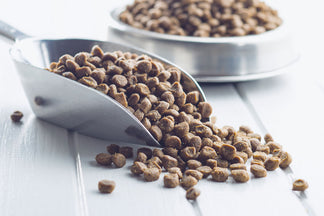Just as with humans, where almost 70 % of U.S. adults are overweight and more than a third are considered obese according to the Center for Disease Control, there is a similar problem with our pets. According to Association for Pet Obesity Prevention, more than half of all dogs and cats in the U.S. are overweight or obese. Other countries, like the United Kingdom, have reported similar sobering statistics. And much like in the human food industry, there is a whole suite of diet pet food products that are marketed to owners of these overweight pets. The question is, are these diet pet food products worth using or not?
As we have previously written about, the key to keeping a pet at an optimal weight is to understand their daily energy requirements to maintain a healthy weight and feed at or below this requirement. Overfeeding will lead to slow and steady weight gain: one pound of excess weight is gained per 3,500 calories fed that are not burned off through activity and basal metabolism. No matter which type of pet food is used, feeding a pet more than their daily requirements will lead to weight gain and an unhealthy pet.
Diet Dog Food: An Analysis
To answer the question of whether or not diet pet food is worthwhile, we studied the dog foods in our database to determine the differences between diet dog food and regular dog food. The average calories per cup and macronutrient (protein, fat, and carbohydrate) profiles of dry and canned food are shown in the graphs below.
Diet dog food is certainly lower in calories than regular dog food. On average, diet dry food is almost 100 calories/cup less than regular dry food. Similarly, diet canned food is approximately 50 calories per cup, less than regular canned food. On the surface, this is not a bad thing and is consistent with the idea of a diet food. The lower calorie food means that, without adjusting your serving amounts, your pet will take in less calories each day. For some perspective, serving your pet 100 less calories per day would result in a one pound weight loss every 35 days or so, which is a pace of about 10 lbs. per year.
However, digging further reveals some troubling data. On average, the diet dog food is much higher in carbohydrates and lower in protein and fat than regular food. Diet dry food contains almost 10% and canned diet food contains almost 15% more carbohydrates than regular dry and wet foods respectively. This is not good. Dogs and cats are meant for diets high in proteins and fats, not high in carbs. Feeding them a high carb diet, even if it is lower in calorie, is not a smart strategy unless your pet has a special condition that requires such a diet.
How to Choose a Diet Pet Food
If you do decide to use a diet food, choose it in the same way that you would choose a regular food. Look at the ingredient list for real named meat, poultry, and fish protein sources and natural, minimally processed ingredients. Evaluate the macronutrient profile for an indication of protein, fat, and carbs and when possible, avoid those that contain higher amounts of carbs. Once you choose a food (diet or otherwise) and assuming that you know how many calories your pet needs each day, make sure to measure accordingly and account for treats. Otherwise you run the risk of continuing to overfeed your pet.
The bottom line is that although diet pet foods can in some cases be a useful tool to help you get your pet to a healthy weight, the real secret is to understand your dog’s calorie needs and make sure you are feeding them the correct amount - no matter which type of food you choose.



 Food
Food
 Food
Food
 Food
Food
